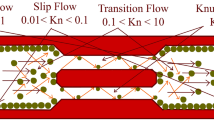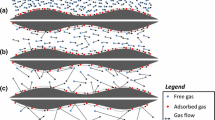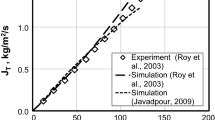Abstract
Various flow regimes including Knudsen, transition, slip and viscous flows (Darcy’s law), as applied to flow of natural gas through porous conventional rocks, tight formations and shale systems, are investigated. Data from the Mesaverde formation in the United States are used to demonstrate that the permeability correction factors range generally between 1 and 10. However, there are instances where the corrections can be between 10 and 100 for gas flow with high Knudsen number in the transition flow regime, and especially in the Knudsen’s flow regime. The results are of practical interest as gas permeability in porous media can be more complex than that of liquid. The gas permeability is influenced by slippage of gas, which is a pressure-dependent parameter, commonly referred to as Klinkenberg’s effect. This phenomenon plays a substantial role in gas flow through porous media, especially in unconventional reservoirs with low permeability, such as tight sands, coal seams, and shale formations. A higher-order permeability correlation for gas flow called Knudsen’s permeability is studied. As opposed to Klinkenberg’s correlation, which is a first-order equation, Knudsen’s correlation is a second-order approximation. Even higher-order equations can be derived based on the concept used in developing this model. A plot of permeability correction factor versus Knudsen number gives a typecurve. This typecurve can be used to generalize the permeability correction in tight porous media. We conclude that Knudsen’s permeability correlation is more accurate than Klinkenberg’s model especially for extremely tight porous media with transition and free molecular flow regimes. The results from this study indicate that Klinkenberg’s model and various extensions developed throughout the past years underestimate the permeability correction especially for the case of fluid flow with the high Knudsen number.
Similar content being viewed by others
Abbreviations
- DSMC:
-
Direct-simulation of Monte Carlo
- LBS:
-
Linearized Boltzmann solution
- MEMS:
-
Micro electro-mechanical systems
- NEMS:
-
Nano electro-mechanical systems
- b k :
-
Klinkenberg’s slippage factor (psi)
- b :
-
Slip coefficient in microflow model
- D :
-
Diffusion coefficient (ft2/day)
- f c :
-
Correction factor (dimensionless)
- H :
-
Microchannel height (ft)
- k :
-
Porous medium permeability to fluid (md)
- k a :
-
Apparent gas permeability (md)
- K B :
-
Boltzmann constant (1.3805 × 10−23 J/K)
- k ∞ :
-
Absolute (Klinkenberg’s corrected) permeability (md)
- Kn :
-
Knudsen number (dimensionless)
- L :
-
Pipe length (ft)
- M :
-
Molecular weight (kg/kmol)
- P :
-
Pressure (psi)
- r :
-
Pore-throat radius (μm)
- R g :
-
Universal gas constant (8.314 J/kg-mole/K)
- T :
-
Temperature (K)
- q :
-
Flow rate (ft3/day)
- u :
-
Velocity in x-direction (ft/s)
- ΔP :
-
Pressure drop (psi)
- a:
-
Apparent
- ads:
-
Adsorbed
- B:
-
Boltzmann
- c:
-
Correction
- g:
-
Gas
- k:
-
Klinkenberg
- α :
-
Dimensionless rarefaction coefficient
- σ :
-
Collision diameter (m)
- ρ :
-
Fluid density (lb/ft 3)
- μ :
-
Dynamic viscosity of fluid (cp)
- \({\phi}\) :
-
Porosity (fraction)
- τ :
-
Tortuosity (dimensionless)
References
Agarwal R.K., Keon-Young Y., Balakrishnan R.: Beyond Navier–Stokes: Burnett equations for flows in the continuum–transition regime. Phys. Fluids 13, 3061–3085 (2001)
Aguilera R.: Incorporating capillary pressure, pore throat aperture radii, hight above free water table, and Winland r 35 values on Pickett plots. AAPG Bull. 86, 605–624 (2002)
Beskok A., Karniadakis G.E.: A model for flows in channels, pipes, and ducts at micro and nano scales. Nanoscale Microscale Thermophys. Eng. 3, 43–77 (1999)
Bird G.A.: Molecular Gas Dynamics. Oxford University Press, London (1976)
Byrnes, A.P.: Cluff, R., Webb, J.: Analysis of critical permeability, capillary pressure and electrical properties for MESAVERDE tight gas sandstones from Western U. S. Basins. Quarterly Technical Progress Report, DOE Contract No. DE-FC26-05NT42660 (2006)
Civan F.: Effective correlation of apparent gas permeability in tight porous media. Transp. Porous Media 82, 375–384 (2010)
Cussler E.L.: Diffusion Mass Transfer in Fluid System. 2nd edn. Cambridge University Press, Cambridge (1997)
Ertekin T., King G.A., Schwere F.C.: Dynamic gas slippage: a unique dual-mechanism approach to the flow of gas in tight formations. SPE Form. Eval. 1, 43–52 (1986)
Florence, F.A., Rushing, J.A., Newsham, K.E., Blasingame, T.A.: Improved permeability prediction relations for low permeability sands. SPE 107954. In: Presented at the 2007 SPE Rocky Mountain Oil and Gas Technology Symposium, Denver, Apr 16–18 (2007)
Forchheimer P.: Wasserbewegug durch Boden, Zeits. V. deutsch. Ing 45, 1782–1788 (1901)
Halpern A.M., Glendening E.D.: Estimating molecular collision diameter using computational methods. J. Mol. Struct. 365, 9–12 (1996)
Heid, J.G., McMahon, J.J., Nielsen, R.F., Yuster, S.T.: Study of the Permeability of Rocks to Homogenous Fluids. pp. 230–246. API Drilling & Production Practice, New York (1950)
Jones, F.O., Owens, W.W.: A laboratory study of low permeability gas sands. SPE 7551. In: Presented at the 1979 SPE Symposium on Low-Permeability Gas Reservoirs, Denver, May 20–22 (1979)
Karniadakis G., Beskok A., Aluru N.: Microflows and Nanoflows: Fundamentals and Simulation. Springer, New York (2005)
Klinkenberg, L.J.: The permeability of Porous Media to Liquid and Gases. paper presented at the API 11th mid year meeting, Tulsa. API Drilling and Production Practices, New York, pp 200–213 (1941)
Knudsen M.: Die Gesetze der Molukularstrommung und der inneren. Reibungsstrornung der Gase durch Rohren. Ann. der Phys. 28, 75–130 (1909)
Knudt A., Warburg E.: Übwe Reibung and Wärmelei-tung verdünnter Gase. Poggendrfs Annalen der physic und Chemie. 155, 337 (1875)
Kolodzie, J.S.: Analysis of pore throat size and use of the Waxman–Smits equation to determine OOIP in Spindle field, Colorado. In: Presented at SPE 55th Annual Technical Conference and Exhibition, Dallas, Sep 21–24 (1980)
Kunert, C., Harting, J.: Roughness induced boundary slip in microchannel flows. Phys. Rev. Lett. 99, 176001(4) (2007)
Loyalka S.K., Hamoodi S.A.: Poiseuille flow of a rarefied gas in a cylindrical tube: solution of linearized Boltzmann equation. Phys. Fluids. A 2, 2061–2065 (1990)
Maxwell J.C.: On stresses in rarefied gases arising from inequalities of temperature. Phil. Trans. Roy. Soc. Lond. 170, 231–256 (1867)
Mayal, F.R., Price E.H., Hill R.E., Kukal G.C., Abadie P.A., Riecken C.C.: Geologic and production characteristics of the tight Mesaverde group: Piceance Basin, Colorado. Technical Report for U.S. Department of Energy, Contract No. DE-AC21-88MC24120 (1989)
Miguel A.F., Serrenho A.: On the experimental evaluation of permeability in porous media using a gas flow method. J. Phys. D 40, 6824–6828 (2007)
Roque-Malherbe R.M.A.: Adsorption and Diffusion in Nanoporous Materials. CRC Press, Taylor & Francis Group, Boca Raton (2007)
Roy S., Raju R., Chuang H.F., Cruden B.A., Meyyappan M.: Modeling gas flow through microchannels and nanopores. J. Appl. Phys. 93, 4870–4879 (2003)
Sampath C.W., Keighin K.: Factors affecting gas slippage in tight sandstones. SPE 9872. J. Petrol. Technol. 34, 2715–2720 (1982)
Sandler S.: Temperature dependence of the Knudsen permeability. Ind. Eng. Chem. Fundam. 11, 424–427 (1972)
Tang G.H., Tao W.Q., He Y.L.: Gas slippage effect on microscale porous flow using the lattice Boltzmann method. Phys. Rev. E 72, 056301-8 (2005)
Wu Y.S., Pruess K., Persoff P.: Gas flow in porous media with Klinkenberg effects. Transp. Porous Media 32, 117–137 (1998)
Zhu, G.Y., Liu, L., Yang, Z.M., Liu, X.G., Guo, Y.G., Cui, Y.T.: Experiment and mathematical model of gas flow in low permeability porous media. New trends in fluid mechanics research. In: Proceedings of the Fifth International Conference on Fluid Mechanics, Shanghai, Aug 15–19 (2007)
Ziarani A.S., Mohamad A.A.: Effect of wall roughness on the slip of fluid in a microchannel. Nanoscale Microscale Thermophys. Eng. 12, 154–169 (2008)
Author information
Authors and Affiliations
Corresponding author
Rights and permissions
About this article
Cite this article
Ziarani, A.S., Aguilera, R. Knudsen’s Permeability Correction for Tight Porous Media. Transp Porous Med 91, 239–260 (2012). https://doi.org/10.1007/s11242-011-9842-6
Received:
Accepted:
Published:
Issue Date:
DOI: https://doi.org/10.1007/s11242-011-9842-6




